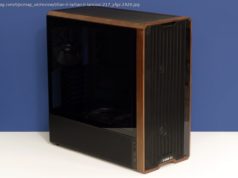BlackBerry’s new Android, the KEYone, comes complete with a real keyboard and is strictly for business. According to our reviewer, it’s also not bad at all.
Use commas to separate multiple email addresses
Your message has been sent.
There was an error emailing this page.
By Dan Rosenbaum
Contributing Writer,
Computerworld | May 4,2017 6: 03 AM
PT
Here are some words I never thought I’d be writing again: There’s a new phone from BlackBerry that you might be interested in. This time, it’s called the KEYone.
It’s not that I’m biased against BlackBerry. I strapped the first one to my hip when it came out in the early 2000s, before smartphones were invented and the only other way to get your email when you were away from your computer was on a two-way pager. (Kids, gather ’round. Gramps is telling his stories again…)
BlackBerry’s signature hard keyboard and secure messaging hub earned it a lot of devotees, particularly among the finance and government crowd. The devices were so ubiquitous in those segments, in fact, that the BlackBerry-toting Master of the Universe became something of an unpleasant cliché.
But the app-iverse of the iPhone and Android pretty much killed BlackBerry, which stood by its proprietary operating system and some handset choices that were eccentric at best. The last few years saw layoffs and lawsuits, with BlackBerry entering the autonomous car software business under the brand QNX and licensing its brand to a company called TCL. Serious telecom geeks will recognize TCL as the parent company of Alcatel — another telecom brand that’s gone through hard times during the last few years.
So now we have the BlackBerry KEYone, a new Android phone from a company that by all rights should be dead. But you know what? There’s life in the old dog yet.
Don’t get me wrong: If you’re looking for a phone that will give you a thrill playing Temple Run or that will smoothly show a high-res Netflix feed, this isn’t it. But if you live and die by email and messaging, if your phone is an umbilical extension of your desk, if you’re one of those diehards still dependent on BlackBerry IT infrastructure, the KEYone is a pretty good phone with a lot to recommend it.
As BlackBerrys tend to be, the KEYone is physically distinctive, even notwithstanding the hard keyboard. It’s a little less than 6 in. tall by about 2.75 in. and 0.4 in. thick — a tiny bit wider and thicker than a Samsung Galaxy S8. Remember the awkwardly sized Passport or the tricky slide-screen Priv? This one’s lots better.
While most current phones have four rounded corners, the KEYone’s top is chopped off square, like a Marine with a crew cut. The sides, bottom and top quarter-inch of the phone are brushed aluminum. Other than that aluminum top, the front of the phone contains a 4.5-in. Gorilla Glass 4 screen and a black plastic keyboard, the four rows of which are separated by thin strips of metal. The back is covered in what looks and feels like black pebbled leather (with the BlackBerry logo prominent in silver) . At 6.3 oz., it’s got a nice feel and heft.
[Further reading: See the latest tech reviews on Computerworld]
There’s a headphone jack at the top edge; a SIM/microSD drawer, volume rocker button and assignable function button on the right edge; two speaker ports and a USB-C port on the bottom edge, and a power button on the left edge. There’s a 12MP camera on the back and a 8MP selfie-cam in front.
Specs are distinctly mid-level. The KEYone uses a Snapdragon 625 chipset, and its 4.5-in. screen shows 1080 x 1620 pixels, which isn’t quite HD quality. The phone comes with 32GB of storage and 3GB of RAM, which is on the upper end of typical, and runs Android 7.1.
Benchmarking was not kind to the KEYone. When I tested it using the Antutu benchmarks, which assess smartphone performance, it ended up with a score of roughly 59000; the Samsung Galaxy S8 phones were in the 160000 range. This is not a phone to get for its performance.
(It’s worthy of note that phones using the same or equivalent processors got about the same test results. For example, the Huawei Honor 6X uses the roughly equivalent Kirin 655 processor and scored 57055. The Moto G5 Plus uses the same Snapdragon 625 and scored 64328.)
Battery life, though, is better than solid. Our intense rundown test got 6.5 hours of life out of the KEYone’s 3505mAh battery, and it quick-charged from zero to 100% in about two hours. More about that a little later, because it’s interesting.
The thing you need to keep in mind about the KEYone is that it’s a purpose-built machine, and that purpose is messaging. It does that very well.
Let’s talk for a minute about the keyboard.
If this isn’t quite the BlackBerry keyboard of years past, it’s still pretty good.
There used to be a small ridge at the top of every key to help you locate your thumbs, but it’s not there anymore and it’s not missed. The top three rows are a QWERTY keyboard; the bottom row has shift keys on either side, a button to turn on the mic for dictation, a SYM key that brings up a soft keyboard of numbers and symbols while still letting you enter the symbols on the hard keyboard, and a space bar that doubles as a fingerprint sensor. Keypresses feel positive and the keys are sculpted enough that there’s never a doubt which one you’re pressing.
BlackBerry makes the claim that despite the small-ish screen, you actually have more working space on the KEYone than on conventional phones because none of the screen is taken up by a soft keyboard. It’s a reasonable point.
There’s no trackball or joystick or weird interface device that marred older BlackBerry phones. Instead, the entire keyboard surface is swipe sensitive, and it’s pretty cool. You can scroll through a document by gently dragging or flicking your thumb up and down along the surface of the keyboard. You can page through your Android apps by flicking your thumb left or right. When you’re writing and want to delete a word, flick left with your thumb, and the word to the left of the cursor is gone. Flicking down on the keyboard will supposedly bring up a soft numeric keypad, but I was never able to make that work. This is nirvana for people who don’t want to change their focus from the keyboard.
But wait, there’s more. Predictive typing is old hat by now, but the KEYone’s got a couple of tricks there, too. As you write, the KEYone will show you a row of three words that it thinks you may want to use or use next. Flicking upward in the middle of the keyboard will insert the middle word in your document; most phones will do that if you press space. But if you flick upwards under the left side of the keyboard, the KEYone inserts the first word in the row, and if you flick up under the right-hand word, it inserts that one. You can build up a real head of writing steam that way.
The only drawback to this arrangement is that I found it easy to brush the fixed capacitive Back, Home and Recent buttons that lie between the top of the keyboard and bottom of the screen. Too often, I’d be writing and flicking away and find myself accidentally dropped back to the Home screen.
The KEYone comes free of carrier bloat and with a complete stack of Google software. But it also comes with set of BlackBerry proprietary software: BBM messaging, DTEK security scanning, keyboard shortcut manager, and the BlackBerry calendar, email, to-do list and contact manager.
Домой
United States
USA — software BlackBerry returns with a surprisingly decent business phone: The KEYone (with video)






